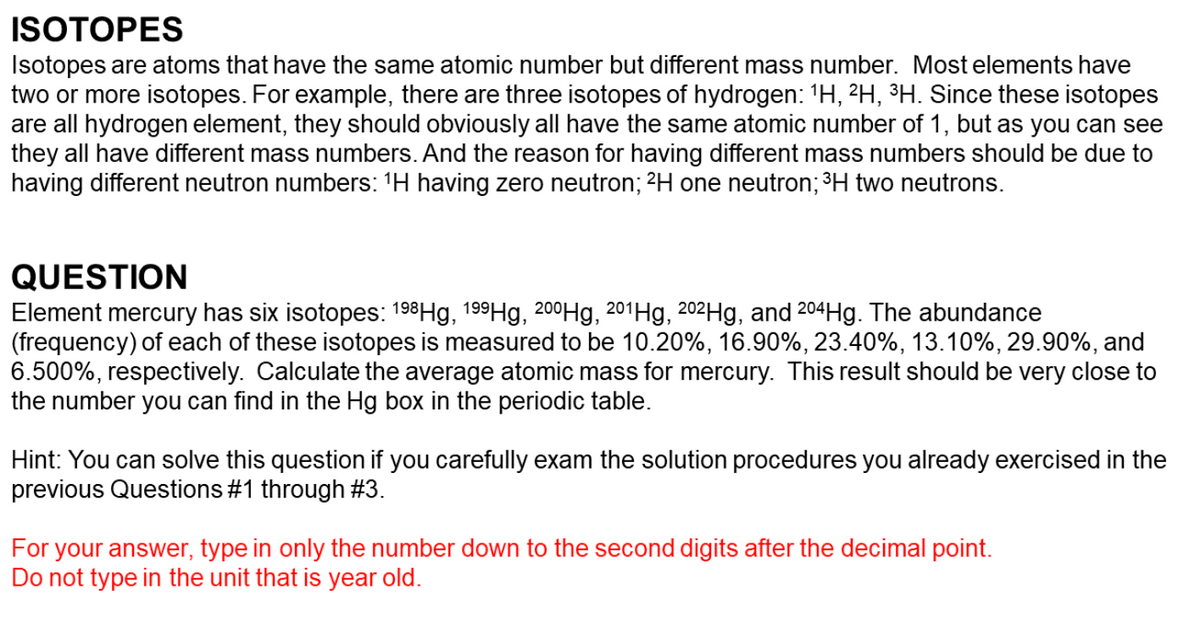they all have different mass numbers. And the reason for having different mass numbers should be due to having different neutron numbers: 1H having zero neutron; 2H one neutron; ³H two neutrons. QUESTION Element mercury has six isotopes: 198Hg, 199Hg, 200Hg, 201Hg, 202Hg, and 204H.. The abundance (frequency) of each of these isotopes is measured to be 10.20%, 16.90%, 23.40%, 13.10%, 29.90%, and 6.500%, respectively. Calculate the average atomic mass for mercury. This result should be very close to the number you can find in the Hg box in the periodic table. Hint: You can solve this question if you carefully exam the solution procedures you already exercised in the previous Questions #1 through #3. For your answer, type in only the number down to the second digits after the decimal point. Do not type in the unit that is year old.
they all have different mass numbers. And the reason for having different mass numbers should be due to having different neutron numbers: 1H having zero neutron; 2H one neutron; ³H two neutrons. QUESTION Element mercury has six isotopes: 198Hg, 199Hg, 200Hg, 201Hg, 202Hg, and 204H.. The abundance (frequency) of each of these isotopes is measured to be 10.20%, 16.90%, 23.40%, 13.10%, 29.90%, and 6.500%, respectively. Calculate the average atomic mass for mercury. This result should be very close to the number you can find in the Hg box in the periodic table. Hint: You can solve this question if you carefully exam the solution procedures you already exercised in the previous Questions #1 through #3. For your answer, type in only the number down to the second digits after the decimal point. Do not type in the unit that is year old.
Introductory Chemistry: An Active Learning Approach
6th Edition
ISBN:9781305079250
Author:Mark S. Cracolice, Ed Peters
Publisher:Mark S. Cracolice, Ed Peters
Chapter5: Atomic Theory : The Nuclear Model Of The Atom
Section: Chapter Questions
Problem 5.4TC
Related questions
Question

Transcribed Image Text:ISOTOPES
Isotopes are atoms that have the same atomic number but different mass number. Most elements have
two or more isotopes. For example, there are three isotopes of hydrogen: 1H, 2H, ³H. Since these isotopes
are all hydrogen element, they should obviously all have the same atomic number of 1, but as you can see
they all have different mass numbers. And the reason for having different mass numbers should be due to
having different neutron numbers: 'H having zero neutron; 2H one neutron; ³H two neutrons.
QUESTION
Element mercury has six isotopes: 198Hg, 199H9, 200Hg, 201H9, 202H9, and 204H9. The abundance
(frequency) of each of these isotopes is measured to be 10.20%, 16.90%, 23.40%, 13.10%, 29.90%, and
6.500%, respectively. Calculate the average atomic mass for mercury. This result should be very close to
the number you can find in the Hg box in the periodic table.
Hint: You can solve this question if you carefully exam the solution procedures you already exercised in the
previous Questions #1 through #3.
For your answer, type in only the number down to the second digits after the decimal point.
Do not type in the unit that is year old.
Expert Solution
This question has been solved!
Explore an expertly crafted, step-by-step solution for a thorough understanding of key concepts.
This is a popular solution!
Trending now
This is a popular solution!
Step by step
Solved in 2 steps with 2 images

Knowledge Booster
Learn more about
Need a deep-dive on the concept behind this application? Look no further. Learn more about this topic, chemistry and related others by exploring similar questions and additional content below.Recommended textbooks for you

Introductory Chemistry: An Active Learning Approa…
Chemistry
ISBN:
9781305079250
Author:
Mark S. Cracolice, Ed Peters
Publisher:
Cengage Learning

Introductory Chemistry: A Foundation
Chemistry
ISBN:
9781337399425
Author:
Steven S. Zumdahl, Donald J. DeCoste
Publisher:
Cengage Learning

Chemistry & Chemical Reactivity
Chemistry
ISBN:
9781133949640
Author:
John C. Kotz, Paul M. Treichel, John Townsend, David Treichel
Publisher:
Cengage Learning

Introductory Chemistry: An Active Learning Approa…
Chemistry
ISBN:
9781305079250
Author:
Mark S. Cracolice, Ed Peters
Publisher:
Cengage Learning

Introductory Chemistry: A Foundation
Chemistry
ISBN:
9781337399425
Author:
Steven S. Zumdahl, Donald J. DeCoste
Publisher:
Cengage Learning

Chemistry & Chemical Reactivity
Chemistry
ISBN:
9781133949640
Author:
John C. Kotz, Paul M. Treichel, John Townsend, David Treichel
Publisher:
Cengage Learning

Chemistry & Chemical Reactivity
Chemistry
ISBN:
9781337399074
Author:
John C. Kotz, Paul M. Treichel, John Townsend, David Treichel
Publisher:
Cengage Learning

Principles of Modern Chemistry
Chemistry
ISBN:
9781305079113
Author:
David W. Oxtoby, H. Pat Gillis, Laurie J. Butler
Publisher:
Cengage Learning

Chemistry: Principles and Practice
Chemistry
ISBN:
9780534420123
Author:
Daniel L. Reger, Scott R. Goode, David W. Ball, Edward Mercer
Publisher:
Cengage Learning